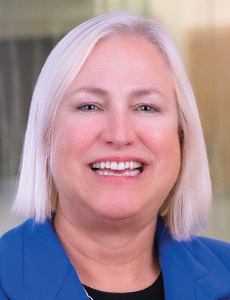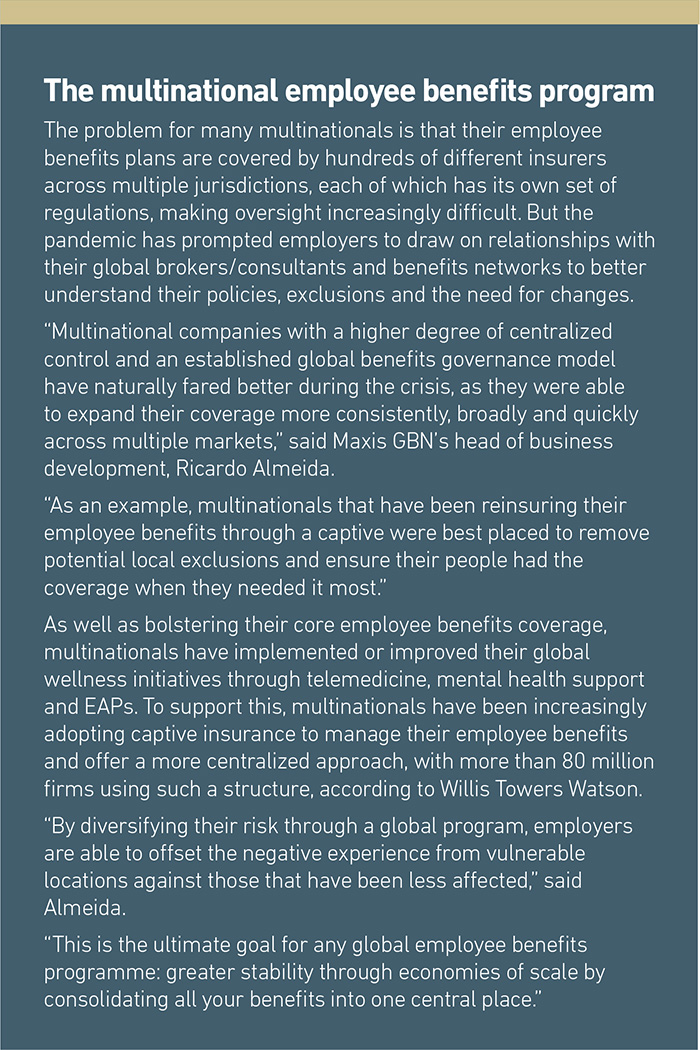Did COVID Sink Your Employee Benefits Plan? Captives Could Be a Lifesaver

The COVID-19 pandemic has forced many employers to rethink their relationship with employees as health and wellbeing have come into sharp focus.
With infection rates still at dangerous levels as well as a steady number of staff working from home, many of whom have developed long-term health problems, the need for comprehensive and affordable medical and health care benefits has never been greater.
At the same time, businesses want to distinguish themselves as the employer of choice in an ever-competitive jobs market, to attract and retain the best talent.
That’s why companies have been expanding their employee benefits plans beyond traditional medical stop-loss, retiree benefits, group term life and long-term disability, to include the likes of digital health care.
“Employers recognize they have a duty of care and responsibility towards employees and their families,” said Maxis GBN’s head of business development, Ricardo Almeida.
“The pandemic shed light on the importance of the employee benefits program as well as several gaps and opportunities to improve the overall system.”
However, providing such schemes that cover everything from telemedicine to enhanced employee assistance programs (EAPs) comes at a considerable financial cost.
Added to that, because of the uncertainty around how the pandemic will affect employee health plan costs, including the consequences of deferred treatments and routine health checks as well as long-term health care, there has been more conservative pricing of employee benefits risks.
To mitigate against health plan cost hikes, in particular, many firms have expanded their wellness programs, including preventative initiatives such as healthy eating and physical activity promotions, as well as extending plans to support employee mental health.
Finding affordable coverage in the traditional market is a challenge in itself, which is why there has been an uptick in businesses turning to captive insurance as a more cost-effective solution that offers greater flexibility to suit their program and better claims control.
It’s not limited to new captives either: Existing programs have been extending their offerings, too.
“Most employers that are self-funded, including those involved in captive programs, have taken similar approaches to the pandemic,” said Ken Gumbiner, head of accident and health sales, North America, at Swiss Re Corporate Solutions.
“In addition to offering the federally-mandated benefits, they have expanded benefits to include telemedicine for all medical conditions that can be treated telephonically at a 100% benefit.”
The Importance of Employee Benefit Plans
The pandemic has merely reinforced the importance of employee benefit plans, with employers prioritizing employee health and safety, said Mike Madden, senior vice president, benefits, North America at Artex. They have also increased their focus on continued access to health care for furloughed workers, while ensuring testing for COVID-19 is covered by their health plans, he added.
“Employers are focusing on physical as well as mental health,” said Madden.
“They are also looking to ensure that their benefit plan remains both relevant and compliant given all the changes related to COVID-19.”
A risk manager, who asked to remain anonymous, said that many short and long-term life, health and disability risks had increased because of COVID-19.
As a result, his company has taken a more preventative approach to its benefits offering by making sure there is greater access to treatments.
“We’ve put in place strategic health and wellbeing programs, and we measure the effectiveness of those based on claims data that comes through the captive,” he said. “Once you have that data, you can evaluate what’s driving claims trends and put in place effective mitigation and prevention strategies.”
Aside from the core benefits employers provide, there has been an increase in the provision of voluntary benefits too, according to a survey by Spring Consulting Group. The study found that accident, critical illness and paid family care leave were the most popular, with 50% of companies saying they offered these benefits.
“Employers have been looking at how they can extend their employee benefits plans,” said Karin Landry, managing partner at Spring Consulting Group.
“This includes the increasingly significant use of voluntary benefits such as short-term disability, extra life insurance, hospital indemnity and critical illness coverage.”
One of the key areas has been the increased access to a host of telephonic and web-based services. Telemedicine has enabled employees to safely access health care in their own homes, with virtual examinations replacing hospital and clinic visits.
“The biggest expansion of care has been the acceleration and acceptance of telemedicine benefits,” said QBE’s head of accident and health, Tara Krauss.
“Providers of care advanced their digital IQ and rapidly rolled out the technological advancements necessary to offer telehealth options to patients.”
In addition to medical benefits, employers have provided greater access to behavioral health assistance and employee leave to address the challenges of COVID-19, including the added pressures of the new ways of working, many of which have adversely affected workers’ mental health and wellbeing.
They have also expanded their benefits coverage to staff who were furloughed due to the pandemic and extended their EAPs to offer more financial advice.
Lately, there has been a surge in the use of group captives by companies with 75 to 400 employees keen to actively improve their quality of care and cost containment, said Gumbiner.
That’s why employer captives are such an attractive proposition, he said.
“Employer captives provide a way for multiple employers to share in the risk together to minimize the volatility they may experience on their own,” said Gumbiner.
“They also benefit from the combined experience of the other members relating to the best administration, pharmacy benefit manager and vendor options.”
Uptake of Captives
The key advantages of using captives to insure employee benefits plans is they can better control risks and claims, and reduce overall health care plan costs. They also offer greater flexibility to meet the needs of specific employee benefits plans.
“The most compelling reason to consider using a captive for employee benefits is achieving greater efficiencies and flexibility of coverage,” said Lorraine Stack, managing director at Marsh Captive Solutions.
“That includes having better control over pricing by eliminating frictional costs, as well as providing greater transparency for the analysis of claims activity.”
Through better analysis of the data, companies can engage in highly-targeted employee initiatives to slash claims and premiums costs. Such schemes can also improve the general staff health and wellbeing, thus increasing productivity and reducing absence.
“By using captive insurance companies to participate in employee benefits programs, companies are able to more efficiently finance existing programs and to use data analytics to drive better decision-making; in terms of both plan structure and claims handling,” said Kathryn Christensen, senior consultant at Aon.
“Most captive programs start with medical stop loss, which doesn’t require a fronting carrier or Department of Labor approval and can fit into the existing plan structure.”
David Wiesner, regional director, employee benefits, at EPIC Insurance Brokers and Consultants, added that the goal for employers using captives to enhance their employee benefit offerings is to provide a preferred way to participate in excess reinsurance.
As stakeholders, employees also directly contribute towards the program’s results, which isn’t the case with commercial reinsurance, he said.
Being in a group captive program as a small to medium-sized employer also reduces a firm’s exposure to the risks and traditional market volatility, enables them to achieve economies of scale and share best practice, thus improving both quality and cost of medical care for their workers.
Larger employers, however, may benefit more from using a single parent captive, particularly if they are already funding the cost of administering and managing that captive for other property and casualty risks.
“Captives provide an effective solution for employers looking to combine the financing of their employee benefits with their property and casualty risks,” said Vermont’s deputy commissioner of captive insurance, Dave Provost.
“In doing so, they also centralize all their risks in one place, ensuring all functions are pulling in the right direction.” &













